Memory
ŠAJKAŠI, AN IMPORTANT CHAPTER OF SERBIAN FREEDOM-LOVING TRADITION
Fearless River Warriors
After the fall of the Despotovina, this river fleet on šajka (war ships) was moved from Belgrade, Smederevo and Kovin far to the north, ”to the Upper Land”. In the 18th century, after the turmoil caused by the Great Vienna War, the Šajkaški corps was formed again in South Bačka, in the area that today carries the name after the šajka warriors. They were very brave and skilled in river battles, excellent engineer, scouts, light horsemen. Later, they became famous all over Europe also as infantry. However, brighter than anything is their tragic heroic defense of Šajkaši from Hungarians in 1848–1849
By: Petar Đurđev
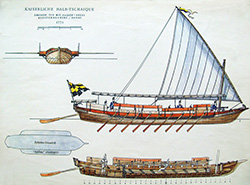 Šajkaška, that little piece of Bačka, is the living thread connecting some of the best warfare traditions of Serbian people. Šajkaši, as a part of the river fleet, are mentioned for the first time in the 15th century on the Danube, Tisa and their tributaries. With their organization and equipment, they build upon the nasadisti, who had been ruling these rivers for centuries before.
Šajkaška, that little piece of Bačka, is the living thread connecting some of the best warfare traditions of Serbian people. Šajkaši, as a part of the river fleet, are mentioned for the first time in the 15th century on the Danube, Tisa and their tributaries. With their organization and equipment, they build upon the nasadisti, who had been ruling these rivers for centuries before.
During the expansion of the Ottoman state, Serbian rulers, in order to defend their estates, had their river troops. For his war fleet, Despot Stefan Lazarević annexed the Belgrade Port on the Danube. 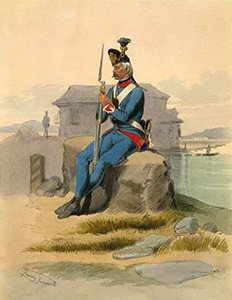 Despot Đurađ Branković also had his fleet. After the fall of Smederevo in 1459, Serbian river warriors were under the command of Vuk Grgurević, grandson of Despot Đurđe Branković. Among the commanders of Šajkaška troops, Petar Ovčarević, Radič Božić, Pavle Bakić, sveti Stevan Štilјanović and Vuk Stančić especially stood out.
Despot Đurađ Branković also had his fleet. After the fall of Smederevo in 1459, Serbian river warriors were under the command of Vuk Grgurević, grandson of Despot Đurđe Branković. Among the commanders of Šajkaška troops, Petar Ovčarević, Radič Božić, Pavle Bakić, sveti Stevan Štilјanović and Vuk Stančić especially stood out.
For the purpose of performing the difficult military duty, Hungarian kings were giving various privileges to Serbian communities. The people who were without their state, saw a chance for survival and progress in performing this truly difficult role. The military spirit was nurtured within family cooperatives. With persistent and strenuous exercises the Šajkaši were getting worthy heirs. Because of all this, the Serbs comprised a part of the human barrier that defended the Christian Europe from the Ottoman expansion.
After the fall of the Despotovina and strengthening of Turkish rule in Srem and Bačka, Šajkaši move from Belgrade, Kovin and Smederevo far to the north, to the Upper Land (that is how they called it). Their military camps then become cities in what is today Hungary and Slovakia: Đer, Ostrogon and Komoran.
BATTALION IN SOUTHERN BAČKA
After the tectonic political changes wrought by the Great Vienna War, and after the Austro-Turkish War of 1737-1739, the War Council in Vienna had to strengthen the defense of borders on the Lower Danube and Sava rivers. That meant that the Šajkaši corps from Đer, Komoran and Ostrogon had to be relocated far to the south. This was followed by demilitarization of Potiska and Pomoriška military border. The Šajkaši officers had to choose: whether they want to join the new Šajkaški corps that was to be formed in Bačka, or to become civilians? After the officers and Šajkaši from the older corps had mostly chosen civilian life, primarily so that in this new organization they would not have to serve as infantry soldiers as well, the new Šajkaški corps was to be formed primarily from the inhabitants of six places in Bačka: Titel, Lok, Gardinovci, Vilovo, Mošorin and Žabalј.
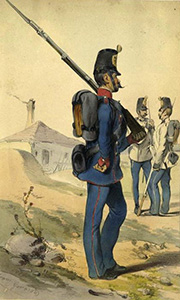 After many proposals, on February 19, 1763, the Court War Council adopted a decision, creating, between the Tisa and Danube, Titel Border officers Šajkaški Battalion. The imperial resolution that confirms this decision was issued on March 6, 1763: ”I hereby agree with the recommendation to form a Šajkaška unit again without much ado, and for this purpose to take the personnel who already performed such duties before.”
After many proposals, on February 19, 1763, the Court War Council adopted a decision, creating, between the Tisa and Danube, Titel Border officers Šajkaški Battalion. The imperial resolution that confirms this decision was issued on March 6, 1763: ”I hereby agree with the recommendation to form a Šajkaška unit again without much ado, and for this purpose to take the personnel who already performed such duties before.”
In order to increase the number of soldiers, in six more municipalities were added to this battalion in 1769: Čurug, Gospođinci, Sentivan (today Šajkaši), Upper and Lower Kovilј and Kać, and later the settlements of Đurđevo and Nadalј, created through population if Serbs from Temerin and Čelarevo. The battalion was providing military service on the Danube, Tisa and Sava. It had to follow the imperial ships and take care for their food. In addition to their service, Šajkaši also had to, outside the borders of the empire, as needed, perform service on water and land, because of which they also had infantry training.
During the war, the šajkaška fleet had to fight against the enemy fleet and perform pioneering-technical works. Šajkaši knew how to, in a very short time – only a few hours – build a pontoon bridge or a smaller fortification . Smaller šajkas had to catch spies, to obtain intelligence on the strength of the enemy army, to deliver messages and maintain liaisons between the land army and the main fleet, and to cause as much damage to the enemy as possible. When necessary, the fleet had to transfer the land army, to build pontoon bridges and secure transfer of the troops. Šajkaška fleet also had small detachments of light cavalry, for scouting and performing emergency works.
SHORT HISTORY OF WARFARE
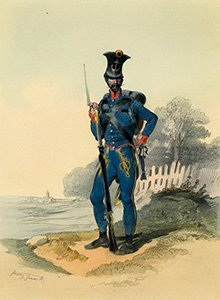 Šajkaški Battalion had its baptism of fire in the War of Bavarian Succession (1778−1779). After the mobilization, Šajkaši were, via Klosterneuburg, sent to the Czech Republic. Their task was to build a bridge near Leitmeritz, as well as to organize transportation of food on the Elba. Šajkaški Battalion fully justified the hopes placed in it, and was much more respected than the imperial pioneers themselves.
Šajkaški Battalion had its baptism of fire in the War of Bavarian Succession (1778−1779). After the mobilization, Šajkaši were, via Klosterneuburg, sent to the Czech Republic. Their task was to build a bridge near Leitmeritz, as well as to organize transportation of food on the Elba. Šajkaški Battalion fully justified the hopes placed in it, and was much more respected than the imperial pioneers themselves.
French declaration of war to Austria, on April 20, 1792, heralded the period of great temptations for the people of Šajkaška. In the next thirteen years, Šajkaši will, for various duties, march into the following today’s countries: Germany, Czech Republic, Slovakia, Poland, Holland, Hungary, Austria, and mostly Italy.
After the fall of the Napoleon’s army in 1812, a coalition was formed against French hegemony in Europe. During this war, Šajkaši were engaged in battlefields in Germany, Italy and France. A company from Šajkaška, under the command of captain Popović, was made available to the Eighth Army Column, a part of which was the Russian corps of General Wittgenstein, in order to enable it to cross the Rhine and city of Kehl. After the Napoleon’s return to power in 1815, majority of war operations were transferred to France. Šajkaši were helping the allied forces to cross the Rhine and supervised the progress up to the occupation of Lyon. When the Second Paris Treaty was finally signed on November 20, 1815, finally returned to their homeland.
All this sacrifice was only an expression of ”blind loyalty” to the Viennese court. Every soldier knew that preservation of the privileged position of Serbian people and Serbian Orthodox church in the Habsburg Monarchy depended on their good behavior. Also not surprising is the care of the court toward Šajkaši, which can be seen in the fact that the greatest Orthodox temples in Bačka were in Šajkaška. Also, the most important Orthodox spiritual center was located in Šajkaška: the monastery in Kovilј.
After the end of the Napoleonic Wars, there was a longer period of peace, which enabled economic and cultural development of Šajkaška. The wave of revolution in 1848 will forever destroy that relative peace and prosperity.
IN THE VORTEXES OF REVOLUTION 1848–1849
During the revolution in 1848, the Hungarian movement required guaranteeing of national rights and autonomy within the Austrian Empire. However, that same movement was not ready to acknowledge national rights to other peoples who lived within Hungary, which was a cause for the outbreak of a civil war. Wanting to protect their own national distinctiveness, at the May Assembly in Sremski Karlovci (May 13 to 15, 1848), the Serbs proclaimed the creation of the Duchy of Serbia, which was supposed to include Banat, Bačka, Srem and Baranja. This chain of events led to armed conflict between the Main Council and Hungarian government, which decided to put an end to this movement with terror and force.
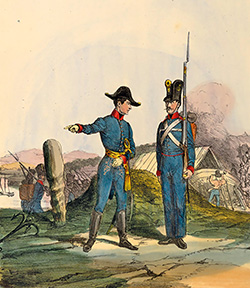 As soon as national movement started in Vojvodina, the Principality of Serbia and Serbian people went to help their brothers over the Sava and Danube. Not only armed volunteers with their leaders were arriving from Serbia, but also all other war material, especially weapons and ammunition. Šajkaška with its military organization, armories and šajka boats was priceless for the preparation of Serbian national army. A military workshop was established in Titel, in which pontoon carts were reworked as mounts for šajka cannons, so that they could be used also as infantry artillery on the ground.
As soon as national movement started in Vojvodina, the Principality of Serbia and Serbian people went to help their brothers over the Sava and Danube. Not only armed volunteers with their leaders were arriving from Serbia, but also all other war material, especially weapons and ammunition. Šajkaška with its military organization, armories and šajka boats was priceless for the preparation of Serbian national army. A military workshop was established in Titel, in which pontoon carts were reworked as mounts for šajka cannons, so that they could be used also as infantry artillery on the ground.
Thanks to the energetic work of Đorđe Stratimirović, former student from Titel, in 1848 the national army grew to include 21,000 soldiers and 104 cannons. With this force, it was necessary to defend the front that was 250 kilometers long against the enemy of 40,000 soldiers. Natural barriers of Šajkaška were Roman dikes and Bačka canal, and exactly those lines were supposed to prepare for the defense. All attacks of the Hungarian government in 1848 failed exactly on these natural borders of Šajkaška.
Turning point in this part of the battlefield occurred after the Battle of Kapolna on February 26–28, 1849. Bad command and recall of volunteers to the Principality of Serbia, which weakened the national army by about 10 thousand soldiers, created favorable conditions for the offensive of revolutionary Hungarian troops.
General Mor Percel managed to break Serbian defense near Sentomaš (today Srbobran), which created favorable conditions for him to conduct an offensive against the area of Šajkaška. On April 6, Hungarian troops occupied Čurug, on April 7 Gospođinci. The Titel Plateau became the only safe haven for the remaining civilians and soldiers. In these decisive moments, patriarch Rajačić sent a plea to Duke Stevan Knićanin and Stratimirović to take over the defense of Šajkaška. Upon request of Stratimirović, Knićanin arrived in Titel with 1,500 volunteers. Stratimirović then declared a state of emergency and kangaroo court for everybody who would leave the Battalion. Soon, people ready to fight began to gather.
On Good Friday 1849, one of the most difficult and most significant victories was achieved for Serbian people north from the Sava and Danube. Approximately an hour after midnight, on April 13, Stratimirović moved toward the enemy over the embankment that led to Đurđevački road. Bold attack of the Serbs surprised the Hungarians. Stratimirović’s troops held that position until Percel began to put together stronger troops against them. The Serbian troops then withdrew to their initial positions, very much encouraged even with that small victory over the stronger enemy. In those decisive moments, Serbian artillery managed to hold the expansion of the enemy.
VILOVO AND MOŠORIN, SERBIAN THERMOPYLAE
 As there were no enemy troops in front of Vilovo, major Jovan Stefanović (the first Serbian hydrologist) decided to help Stratimirović. He handed over the command over troops near Vilovo to captain Kostić, father of famous poet Laza Kostić, and moved toward Sentivan (today Šajkaš) with two companies of Šajkaši, one hundred Serbian volunteers and three cannons. After the artillery battle, the Hungarians on two occasions attacked Serbian positions, but the decisive defense of the defenders made them run away. The Titel Plateau remained under Serbian control. Vilovo and Mošorin became Serbian Thermopylae! This victory is one of the most important Serbian battles, because it proved to be decisive for the survival of Serbian people in these areas.
As there were no enemy troops in front of Vilovo, major Jovan Stefanović (the first Serbian hydrologist) decided to help Stratimirović. He handed over the command over troops near Vilovo to captain Kostić, father of famous poet Laza Kostić, and moved toward Sentivan (today Šajkaš) with two companies of Šajkaši, one hundred Serbian volunteers and three cannons. After the artillery battle, the Hungarians on two occasions attacked Serbian positions, but the decisive defense of the defenders made them run away. The Titel Plateau remained under Serbian control. Vilovo and Mošorin became Serbian Thermopylae! This victory is one of the most important Serbian battles, because it proved to be decisive for the survival of Serbian people in these areas.
Hungarian troops attacked Serbian-Austrian positions in Šajkaška also on April 22, May 22–24, May 26, and June 1 and 2, 1849. All attacks were defended.
After these failures, the commander of the Hungarian army in Bačka, General Feter, received an order to conquer the Titel Plateau in July at all costs. In order to secure this attack as good as possible, after the order of the Hungarian war command, a naval ship was sent down the Tisa to participate in it. Total Hungarian forces in this last attack on the Titel Plateau, according to Jovan Stefanović Vilovski, a participant in this confrontation, was 22,000 soldiers and 40 cannons. But the Hungarian army was defeated again. Šajkaši, the forged warriors, Serbs, volunteers from Bačka and other participants in this horrible battle – the last battle on Vilovo, Mošorin, Kamen and Titel – managed to defend their positions. With desperate defense, a small bastion of Serbian resistance and freedom in what was then Southern Hungary was preserved. These bright and touching victories multiplied the significance of Šajkaška for the development and final success of the national movement from 1848–1849.
The victory was paid an extremely high price: almost all villages of Šajkaška were burned and looted, and in 1848-49, this area lost about 22 percent of the population.
HAT OF THE ŠAJKAŠI
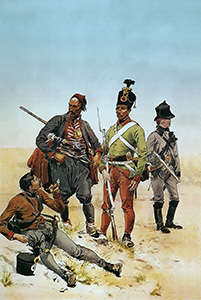 During these battles, volunteers from Šumadija for the first time saw a new hat, which will in future decades become one of the most recognizable Serbian national symbols. Of course, it is šajkača hat.
During these battles, volunteers from Šumadija for the first time saw a new hat, which will in future decades become one of the most recognizable Serbian national symbols. Of course, it is šajkača hat.
Pursuant to the regulation on military dress of border soldiers from 1828 and 1840, in addition to čak, we also find the camp hat called lagermütze or furagier mütze, made of dark brown fabric, with simple and practical cut. Huge black border čako, made of hard material, in the 1840’s became smaller, and more practical to wear. At the same time, the new type of hat is being increasingly used, called lagerrmütze, which was even more practical than čak for the performing of camp and military duties.
No doubt that this hat – later called šajkača – first arrived in Šumadija during the Revolution of 1848-49. tens of thousands of refugees then had to leave the Duchy of Serbia and look for shelter in the Principality of Serbia, while their bravest sons fought heavy battles against Kossuth’s army.
Šajkača, named after Šajkaši, was officially included in the equipment of Serbian national army in 1870. According to the regulation from the same year, it was made of felt or fabric and was supposed to have the shape of frontiers’ hat. Frontiers’ hat was different from Serbian šajkača only in the manner in which it was worn. Both were actually similar to a light lake military hats, then used also in other European armies.
AND THE ”NEW TIMES” ARRIVED
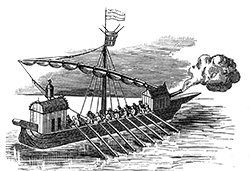 Not long after the end of the war, new changes occurred. Appearance of steam boats led to disappearance of šajkas from the Tisa and the Danube. In imperial resolution, in 1852 the battalion was moved to the infantry frontier’s battalion in Titel. Formerly famous river warriors successfully performed their military tasks as infantry in the wars led by Austria against Piedmont, Prussia and France.
Not long after the end of the war, new changes occurred. Appearance of steam boats led to disappearance of šajkas from the Tisa and the Danube. In imperial resolution, in 1852 the battalion was moved to the infantry frontier’s battalion in Titel. Formerly famous river warriors successfully performed their military tasks as infantry in the wars led by Austria against Piedmont, Prussia and France.
As the result of intensive technological development, innovations in organization of military systems, and weakening of Ottoman dangers, the institution of Military Frontier became unnecessary for the Viennese court. Formerly a human barrier, which for centuries defended the Christian Europe from the Ottoman expansion, was getting ready to start a life in a new reality. The last Šajkaši captains left their command posts on the Day of St. Dmitri (Mitrovdan) in 1872.
The government was not paying attention at all about the specificities of Šajkaška, and transfer from military to civilian administration opened a series of problems that would be partially solved only in 1918. Exactly because of this, only a few decades after the demilitarization, the memory of military administration was idealized in Serbian folk memory as a period of great wealth and peace.
Šajkas disappeared from the rivers, and the memory of these brave Serbian warriors started to fade. It was preserved among the people primarily in folk songs.
***
Liberation of Belgrade
In the Third Austro-Turkish War, from 1787 to 1791, Šajkaši especially stood out in operations of liberation of Belgrade, on October 7, 1789, and during the occupation of Nova Oršava. Then they participated in the unsuccessful attack on Vidin and in defending Mala Vlaška. After the Svištovski Treaty, Šajkaški Battalion returned to peace regime on September 1, 1791.
***
Organization in 1848.
In 1848, Šajkaški Battalion was territorially divided into six companies.
Fourteen villages of Šajkaši formed six regional companies: Gospođinci with Nadalј. Čurug. Žabalј. Đurđevo with Sentivan. Upper and Lower Kovilј, Kać and Gardinovci. Titel with Mošorin, Vilovo and Lok.
The battalion headquarters were in Titel. Besides this, during the war Šajkaški Battalion also formed two reserve and two ground defensive companies.
